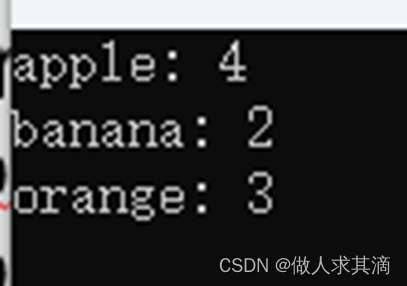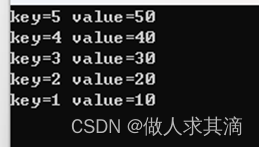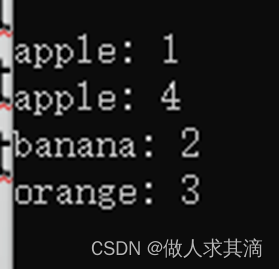map/multimap容器
map基本概念
⭕map 是有序键值对容器,它的元素的键是唯一的。
⭕map中所有元素都是pair,pair中第一个元素为key(键值),起到索引作用,第二个元素为value(实值),所有元素都会根据元素的键值自动排序
⭕本质:map/multimap属于关联式容器,底层结构用二叉树(红黑树)实现。
⭕优点:可以根据key值快速找到value值
map和multimap区别
- map不允许容器中有重复key值元素
- multimap允许容器中有重复key值元素
#include <iostream>
#include <map>
#include <string>
using namespace std;
int main() {
map<string, int> my_map;
my_map["apple"] = 1;
my_map["banana"] = 2;
my_map["orange"] = 3;
// 插入一个已经存在的键值对,会覆盖原来的值
my_map["apple"] = 4;
// 输出map中的元素
for (const auto& it : my_map) {
cout << it.first << ": " << it.second << endl;
}输出

#include <iostream> #include <map> #include <string> using namespace std; int main() { multimap<string, int> my_multimap; my_multimap.insert(make_pair("apple", 1)); my_multimap.insert(make_pair("banana", 2)); my_multimap.insert(make_pair("orange", 3)); // 插入一个已经存在的键值对,不会覆盖原来的值 my_multimap.insert(make_pair("apple", 4)); // 输出multimap中的元素 for (const auto& it : my_multimap) { cout << it.first << ": " << it.second << endl; } }
输出:
map构造和赋值
⭕功能描述:对map容器进行构造和赋值操作。
⭕函数原型:
map<type1name, type2name> maps;//第一个是键的类型,第二个是值的类型
构造一般是通过pair来实现
⭕赋值:
![]()
#include <iostream> #include <map> using namespace std; void PrintMap(map<int, int>& m) //使用迭代器打印 { for (map<int, int>::iterator it = m.begin(); it != m.end(); it++) { cout << "key=" << (*it).first << ' ' << "value=" << (*it).second << " " ; } cout << endl; } void test01() { map<int, int> m1; m1.insert(pair<int, int>(1, 10)); m1.insert(pair<int, int>(2, 20)); m1.insert(pair<int, int>(3, 30)); m1.insert(pair<int, int>(4, 40)); PrintMap(m1); map<int, int>m2(m1); //m1赋值到m2 PrintMap(m1); map<int, int>m3; m3 = m2; //m2赋值到m3 PrintMap(m3); } int main() { test01(); return 0; }
输出:

⭕总结:map中所有元素都是成对出现,插入数据时要使用对组。
map大小和交换
⭕功能描述:统计map容器大小以及交换map容器
⭕函数原型:
size() 返回map中元素的个数
empty() 如果map为空则返回true
swap() 交换两个map
#include <iostream> #include <map> using namespace std; void PrintMap(map<int, int>& m) { for (map<int, int>::iterator it = m.begin(); it != m.end(); it++) { cout << "key=" << (*it).first << ' ' << "value=" << (*it).second << " "; } cout << endl; } void test01() { map<int, int> m1; //创造一个键值为1,2,3,4的map容器 m1.insert(pair<int, int>(1, 10)); m1.insert(pair<int, int>(2, 20)); m1.insert(pair<int, int>(3, 30)); m1.insert(pair<int, int>(4, 40)); PrintMap(m1); if (m1.empty()) //判断m1是否为空 { printf("空\n"); } else { printf("不空\n"); cout<< "大小 = " << m1.size() << endl; } map<int, int> m2; //创造一个键值为10,20,30,40的map容器 m2.insert(pair<int, int>(10, 1)); m2.insert(pair<int, int>(20, 2)); m2.insert(pair<int, int>(30, 3)); m2.insert(pair<int, int>(40, 4)); printf("交换前\n"); cout << "m1: "; PrintMap(m1); cout << "m2: "; PrintMap(m2); printf("交换后\n"); m1.swap(m2); //swap交换 cout << "m1: "; PrintMap(m1); cout << "m2: "; PrintMap(m2); } int main() { test01(); return 0; }- 输出:

⭕总结:
- 统计大小——size
- 判断是否为空——empty
- 交换容器——swap
map插入和删除
⭕功能描述: map容器进行插入数据和删除数据
⭕函数原型:

#include <iostream> #include <map> using namespace std; void PrintMap(map<int, int>& m) { for (map<int, int>::iterator it = m.begin(); it != m.end(); it++) { //map可以使用it->first来访问键,it->second来访问值: cout << "key=" << it->first << " " << "value=" << it->second << endl; } cout << endl; } void test01() { map<int, int>m1; //第一种 m1.insert(pair<int, int>(1, 10)); //第二种 m1.insert(make_pair(2, 20)); //第三种 m1.insert(map<int, int>::value_type(3, 30)); //第四种 m1[4] = 40; cout << m1[4] << endl; PrintMap(m1); m1.erase(m1.begin()); PrintMap(m1); m1[1] = 10; m1.erase(3); //按照key删除 PrintMap(m1); m1.erase(m1.begin(), m1.end()); //全部删完了 PrintMap(m1); m1.clear(); //清空m1 PrintMap(m1); } int main() { test01(); return 0; }
输出:

⭕总结:map插入方式很多,记住其一即可
- 插入——insert
- 删除——erase
- 清空——clear
map查找和统计
⭕功能描述:对map容器进行查找和数据以及统计数据
⭕函数原型:
find() 查找一个元素(返回迭代器)
count() 返回指定元素出现的次数
#include <iostream> #include <map> using namespace std; void PrintMap(map<int, int>& m) { for (map<int, int>::iterator it = m.begin(); it != m.end(); it++) { cout << "key=" << it->first << " " << "value=" << it->second << endl; } cout << endl; } void test01() { map<int, int>m1; m1.insert(pair<int, int>(1, 10)); m1.insert(pair<int, int>(2, 20)); m1.insert(pair<int, int>(3, 30)); map<int, int>::iterator pos = m1.find(3);//返回迭代器 if (pos != m1.end()) { cout << "找到了" << ' ' << pos->first << " " << pos->second << endl; } else { cout << "没找到" << endl; } //map不允许插入重复key, 0 or 1 //返回指定元素出现的次数,map只能是1,multimap可以大于1,可以重复 int num = m1.count(3); cout << num << endl; } int main() { test01(); return 0; }
输出:

⭕总结:
- 查找——find(返回的是迭代器)
- 统计——cout(对于map,结果为0或1)
map容器排序
⭕学习目标:map容器默认排序为按照key值进行从小到大排序,掌握如何改变排序规则。map模板中的第三个参数可以指定排序规则。
⭕主要技术点:利用仿函数,可以改变排序规则。
#include <iostream>
#include <map>
#include <algorithm>
using namespace std;
/*
函数对象的概念
概念:
重载函数调用操作符的类,其对象常称为函数对象。例如上面代码中的MyCompare类
函数对象使用重载的()时,行为类似函数调用,也叫仿函数
本质:
函数对象(仿函数)是一个类,不是一个函数
特点:
函数对象在使用时,可以像普通函数那样调用,可以有参数,可以有返回值
函数对象超出普通函数的概念,函数对象可以有自己的状态
函数对象可以作为参数传递
上述原文链接:https://blog.csdn.net/u011541946/article/details/108044498
*/
class MyCompare
{
public:
bool operator()(int v1, int v2)const //重载()
{
return v1 > v2; //排倒序
}
};
void PrintMap(map<int, int, MyCompare>& m)
{
for (map<int, int, MyCompare>::iterator it = m.begin(); it != m.end(); it++)
{
cout << "key=" << it->first << " " << "value=" << it->second << endl;
}
cout << endl;
}
void test01()
{
map<int, int, MyCompare>m1; //MyCompare类需要放入<>中
m1.insert(make_pair(1, 10));
m1.insert(make_pair(2, 20));
m1.insert(make_pair(3, 30));
m1.insert(make_pair(4, 40));
m1.insert(make_pair(5, 50));
PrintMap(m1);
}
int main(void)
{
test01();
return 0;
}输出:

⭕总结:
- 利用仿函数可以指定map容器的排序规则
- 对于自定义数据类型,map必须要指定排序规则,同set容器
本文含有隐藏内容,请 开通VIP 后查看
